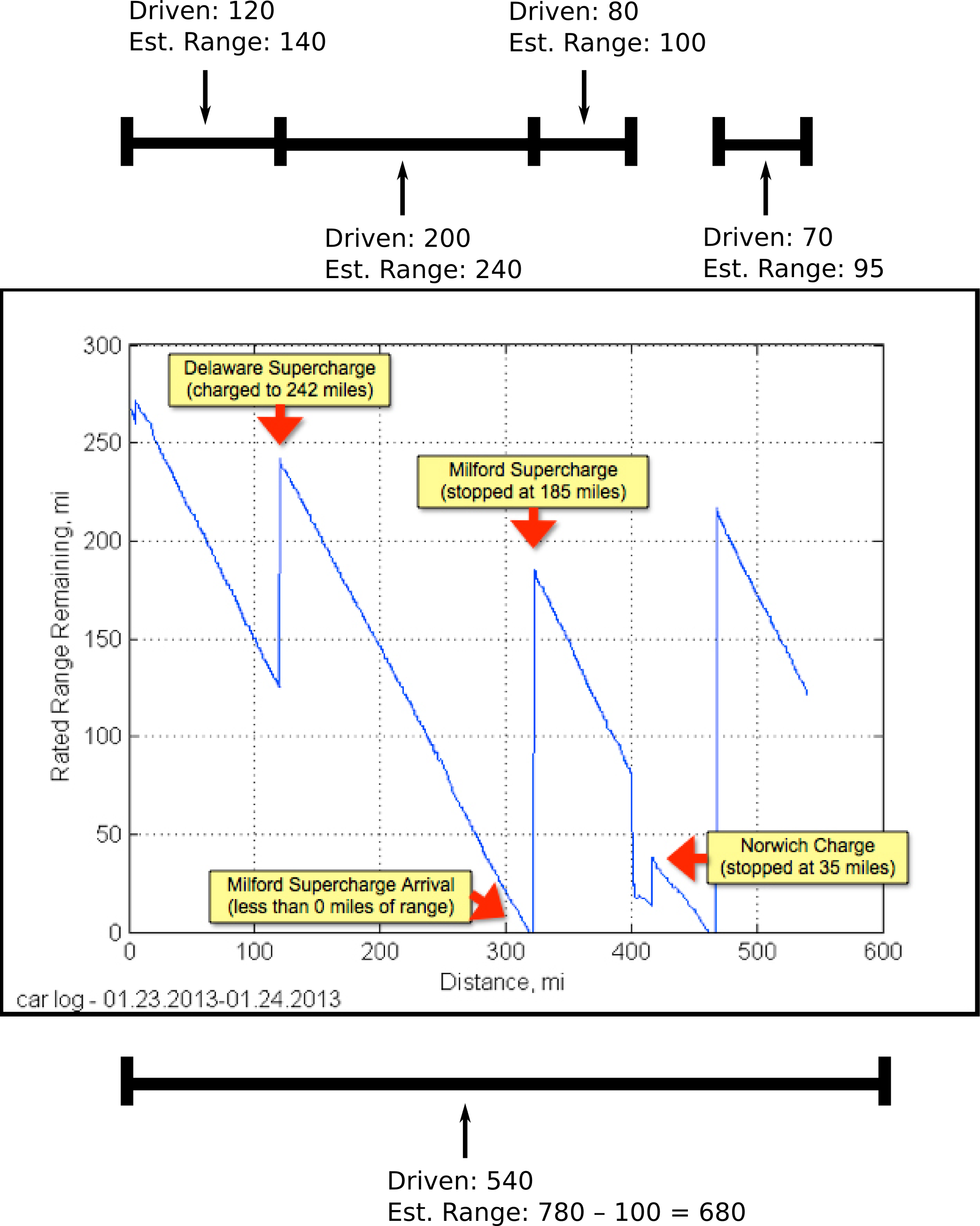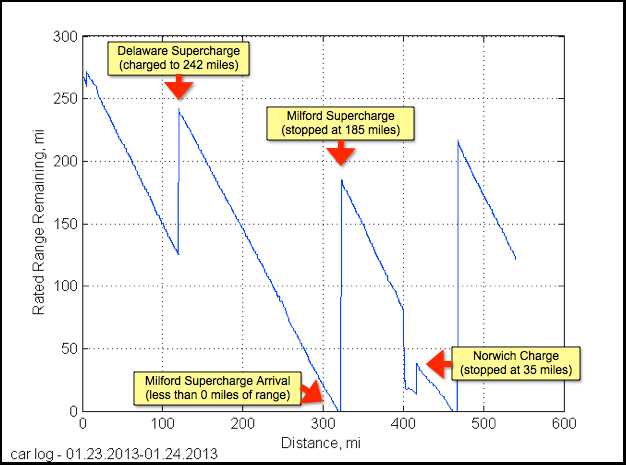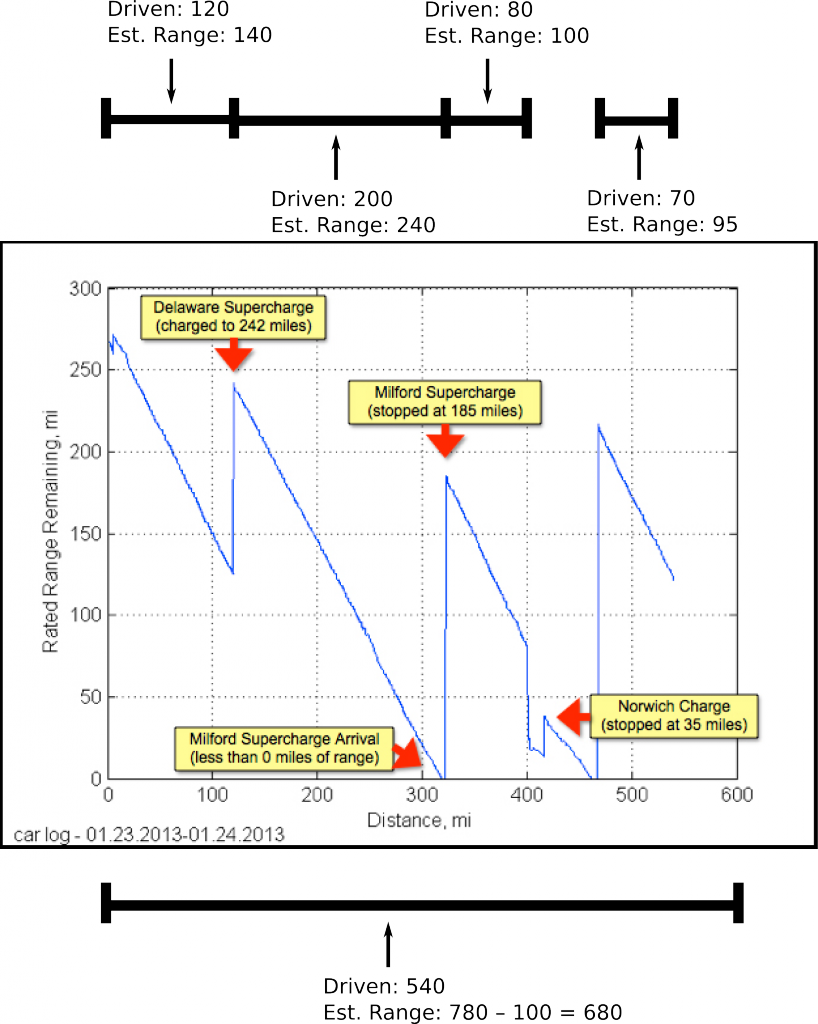A recent article by John Broder in the New York Times about Tesla’s new Model S sedan drove a great deal of controversy about whether the journalist told the truth in his review of the electric car. Elon Musk responded yesterday, aiming to refute what the journalist said. However, the Tesla data purported to prove a series of lies raises some questions of its own. Let’s take a look.
Perhaps the most interesting data, in this respect, is the graph showing predicted range vs actual miles driven.
When I looked at this graph more closely, something unusual stood out. The change in the Tesla’s estimated range didn’t seem to match up with the number of miles actually driven between charges. To make it more clear, I annotated the graph to show the change in the estimated range and the number of miles driven (based on my reading of the graph):
Now, all becomes clear. In nearly every case, the Tesla gets about 20% fewer miles out of each charge than it estimated. Throughout the entire drive of ~540 miles, the estimated range based on combining all charges, then subtracting the remaining charge (scaled down by 20%, consistent with each subsection of the drive), we see a global loss of ~20% in achieved mileage vs estimated range.
In other words, if you’re driving the Model S and not watching the estimate closely throughout the entirety of a longer drive, the initial mileage estimate could fall well short of your goal. About 20%, at least for this data and this driver. So regardless of any disputes over Broder’s driving speed, it seems reasonable to conclude that he could have fallen somewhat short of his goal if he only looked at the charge when beginning each segment of the trip.
Update: The Atlantic Wire also posted a worthwhile consideration of Elon Musk’s blog. Read the comments too.
Disclosure: Tesla Motors is not a client.





Vivek Reddy says:
February 14, 2013 at 1:40 pm
This does not factor how Broder drove the car. Tesla’s data suggested Broder drove significantly faster than what was suggested, which would justify the lower mileage.
Granted, the readings may not be completely accurate, but the data you present is not conclusive to suggest that the actual mileage will always be 20% less than what’s suggested.
RefriedBeans says:
February 14, 2013 at 1:48 pm
True.
But from a technical perspective, after 50, or 100, or 500 miles, why can’t the mileage estimator correct itself based on the habits of its driver and/or its own miscalibration? That’s not rocket science.
greggman says:
February 14, 2013 at 1:56 pm
Really? I don’t know any gas powered cars that estimate this any better. If I’m driving down the freeway SF to LA at 65 they’ll give me vastly different estimate than if I’m driving stop and go around the city. They can’t predict the future so they can’t know if their current prediction is going to match my behavior even a few moments in the future.
Donnie Berkholz says:
February 14, 2013 at 1:54 pm
Thanks for your comment! You’re right that “always” is a strong word. I do find it interesting how consistently it falls short, however, despite the variation in driving styles indicated in the graph of Broder’s speed over time.
Abhishek Ghose says:
February 14, 2013 at 1:51 pm
I am confused – isn’t this what most of the debate essentially about, and this is already known? That the estimates don’t read right? In his article, Broder explicitly says so “… I noticed that the estimated range was falling faster than miles were accumulating …”
Donnie Berkholz says:
February 14, 2013 at 1:56 pm
That’s why I’m addressing the data itself in Elon Musk’s response, which I said is attempting to prove Broder wrong about basically everything he said, but instead supports Broder in some aspects.
Floyd Wilson says:
February 14, 2013 at 2:13 pm
The debate is actually about Broder lying about why the car fell short of the estimates. He drove faster than average and he claimed which reduced range. He cranked the heat up when the battery was low which reduced range.
Abhishek Ghose says:
February 14, 2013 at 8:02 pm
Exactly.
Robert says:
February 14, 2013 at 2:04 pm
Many cars today calculate an estimated range. Does anyone trust the number given when you just gassed up, vs. what it is closer to empty (where the estimate converges with reality). Estimated range is just that, an estimate. As with any car, one should always be aware of what is left in the tank (or battery) and know where you can get fueled up (or recharged).
dwash59 says:
February 14, 2013 at 2:19 pm
But for a normal car, it does not usually matter; you can get to a gas station, particularly on the I-95 corridor where this drive was conducted. For a Tesla, getting to a charger can be difficult, an accurate estimate is necessary.
Donation Dude says:
February 14, 2013 at 4:44 pm
Reporting on car stirs up more emotions then fake reporting by the same media on false wars and the taking of our liberties .
What were developers reading on my blog and tweetstream in 2013? – Donnie Berkholz's Story of Data says:
January 6, 2014 at 9:28 am
[…] 2488: Tesla vs NY Times: A deeper look at the data […]